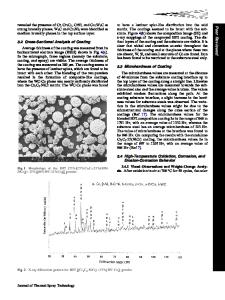Mechanical and High-Temperature Tribological Properties of Cr 3 C 2 -NiCr/TiN Duplex Coating
- PDF / 5,409,701 Bytes
- 14 Pages / 593.972 x 792 pts Page_size
- 92 Downloads / 375 Views
JMEPEG https://doi.org/10.1007/s11665-020-05226-6
Mechanical and High-Temperature Tribological Properties of Cr3C2-NiCr/TiN Duplex Coating Lunlin Shang, Wensheng Li, Dongqing He
, Pengjun Tang, Guangan Zhang, and Zhibin Lu
Submitted: 28 May 2020 / Revised: 19 September 2020 / Accepted: 11 October 2020 Preparation of duplex coating is an innovative way to improve components surface in terms of mechanical and tribological properties by the combination of high velocity oxy-fuel (HVOF) and physical vapor deposition (PVD) technologies. The present work focused on the construction, mechanical properties and high temperature tribological behaviors of the duplex coating consisting of a thick HVOF Cr3C2-NiCr interlayer and a thin PVD TiN top layer, as well as compared it with the Cr3C2-NiCr coating and the single TiN film. The results showed that the Cr3C2-NiCr/TiN duplex coating exhibited higher hardness, elastic modulus, H/E and H3/E2 ratios and superior load-bearing capacity than the single TiN film. The introduction of Cr3C2-NiCr intermediate layer did not affect the microstructure of TiN film but significantly improved the adhesion strength between TiN film and substrate, as well as the wear resistance sliding against WC ball at different temperatures. In addition, the friction and wear mechanism of the Cr3C2-NiCr coating, TiN film and Cr3C2-NiCr/TiN duplex coating was revealed by investigating the friction-induced morphological and structural evolutions of the sliding surface at elevated temperature. Keywords
duplex coating, high temperature, properties, tribological properties
mechanical
1. Introduction Surface engineering technologies are mainly used to improve the wear resistance, anticorrosion, heat resistance and fatigue strength of the componentsÕ surface, so as to ensure the reliable and long-life operation of modern machinery under harsh conditions. Among them, high velocity oxy-fuel (HVOF) thermal spraying coatings and physical vapor deposition (PVD) films are expected to be used for modification and strengthening of metal substrates. PVD films (e.g., DLC, CrN, TiN) play an important role for improving the properties in the applications which involve high contact stresses, severe sliding wear, acid and alkali corrosion and so on (Ref 1-4). However, the differences in hardness, stiffness and coefficient of thermal expansion (CTE) between the metal substrates and PVD thin hard films cause stress concentration on the film-substrate interface or high tensile contact stress within hard films, thus resulting in collapse of the films, the so-called ‘‘egg scale effect’’ (Ref 5-10). HVOF coatings are capable to protect Lunlin Shang, School of Materials Science and Engineering, Lanzhou University of Technology, Lanzhou 730050, China; and State Key Laboratory of Solid Lubrication, Lanzhou Institute of Chemical Physics, Chinese Academy of Sciences, Lanzhou 730000, China; Wensheng Li, Dongqing He, and Pengjun Tang, School of Materials Science and Engineering, Lanzhou University of Technology, Lanzhou 730050, China; and State Key
Data Loading...











